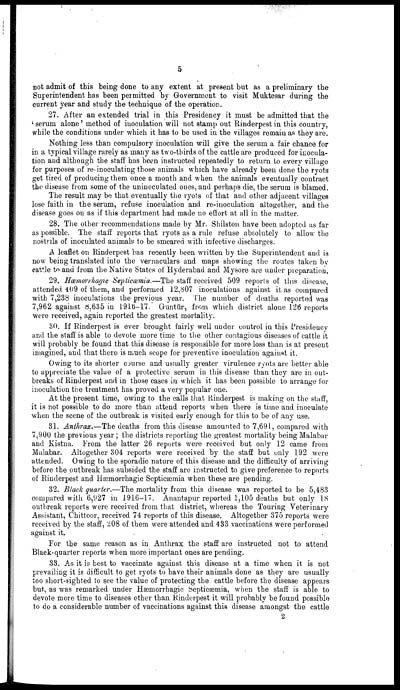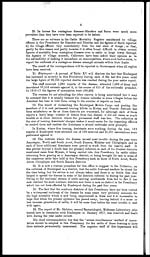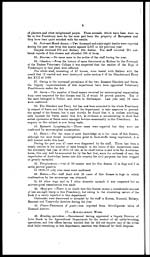Medicine - Veterinary > Civil Veterinary Departments > 1910-1933 - Annual administration report of the Civil Veterinary Department, Madras Presidency > 1910-1925 - Civil Veterinary Department. Madras. Admin. report 1910-25 > 1917-1918 - Annual administration report of the Civil Veterinary Department Madras Presidency for 1917-18
(227) Page 5
Download files
Individual page:
Thumbnail gallery: Grid view | List view

5
not admit of this being done to any extent at present but as a preliminary the
Superintendent has been permitted by Government to visit Muktesar during the
current year and study the technique of the operation.
27.After an extended trial in this Presidency it must be admitted that the
'serum alone' method of inoculation will not stamp out Rinderpest in this country,
while the conditions under which it has to be used in the villages remain as they are.
Nothing less than compulsory inoculation will give the serum a fair chance for
in a typical village rarely as many as two-thirds of the cattle are produced for inocula-
tion and although the staff has been instructed repeatedly to return to every village
for purposes of re-inoculating those animals which have already been done the ryots
get tired of producing them once a month and when the animals eventually contract
the disease from some of the uninoculated ones, and perhaps die, the serum is blamed.
The result may be that eventually the ryots of that and other adjacent villages
lose faith in the serum, refuse inoculation and re-inoculation altogether, and the
disease goes on as if this department had made no effort at all in the matter.
28.The other recommendations made by Mr. Shilston have been adopted as far
as possible. The staff reports that ryots as a rule refuse absolutely to allow the
nostrils of inoculated animals to be smeared with infective discharges.
A leaflet on Rinderpest has recently been written by the Superintendent and is
now being translated into the vernaculars and maps showing the routes taken by
cattle to and from the Native States of Hyderabad and Mysore are under preparation.
29.Hæmorrhagic Septicæmia.—The staff received 509 reports of this disease,
attended 409 of them, and performed 12,807 inoculations against it as compared
with 7,238 inoculations the previous year. The number of deaths reported was
7,962 against 8,635 in 1916-17. Gunt?r, from which district alone 126 reports
were received, again reported the greatest mortality.
30.If Rinderpest is ever brought fairly well under control in this Presidency
and the staff is able to devote more time to the other contagious diseases of cattle it
will probably be found that this disease is responsible for more loss than is at present
imagined, and that there is much scope for preventive inoculation against it.
Owing to its shorter course and usually greater virulence ryots are better able
to appreciate the value of a protective serum in this disease than they are in out-
breaks of Rinderpest and in those cases in which it has been possible to arrange for
inoculation the treatment has proved a very popular one.
At the present time, owing to the calls that Rinderpest is making on the staff,
it is not possible to do more than attend reports when there is time and inoculate
when the scene of the outbreak is visited early enough for this to be of any use.
31.Anthrax.—The deaths from this disease amounted to 7,691, compared with
7,900 the previous year; the districts reporting the greatest mortality being Malabar
and Kistna. From the latter 26 reports were received but only 12 came from
Malabar. Altogether 304 reports were received by the staff but only 192 were
attended. Owing to the sporadic nature of this disease and the difficulty of arriving
before the outbreak has subsided the staff are instructed to give preference to reports
of Rinderpest and Hæmorrhagic Septicæmia when these are pending.
32.Black quarter.—The mortality from this disease was reported to be 5,483
compared with 6,927 in 1916-17. Anantapur reported 1,105 deaths but only 18
outbreak reports were received from that district, whereas the Touring Veterinary
Assistant, Chittoor, received 74 reports of this disease. Altogether 375 reports were
received by the staff, 208 of them were attended and 433 vaccinations were performed
against it.
For the same reason as in Anthrax the staff are instructed not to attend
Black-quarter reports when more important ones are pending.
33.As it is best to vaccinate against this disease at a time when it is not
prevailing it is difficult to get ryots to have their animals done as they are usually
too short-sighted to see the value of protecting the cattle before the disease appears
but, as was remarked under Hæmorrhagic Septicæmia, when the staff is able to
devote more time to diseases other than Rinderpest it will probably be found possible
to do a considerable number of vaccinations against this disease amongst the cattle
2
Set display mode to: Large image | Zoom image | Transcription
Images and transcriptions on this page, including medium image downloads, may be used under the Creative Commons Attribution 4.0 International Licence unless otherwise stated. ![]()
| Permanent URL | https://digital.nls.uk/75699418 |
|---|




